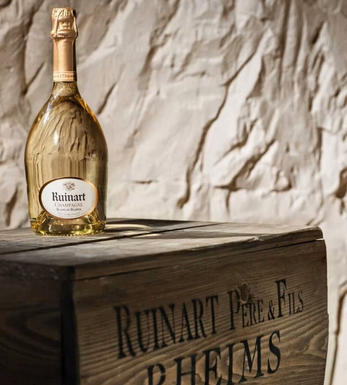
About this WINE

Champagne Ruinart
Ruinart is a low profile, yet select, Champagne house which is steeped in history. It dates back to the 17th century, the time of the famous Dom Pérignon. It was founded in 1729 by Nicolas Ruinart in the city of Reims, the year after a Royal Decree in 1728 whereby Louis XV gave his consent for sparkling wines to be shipped in baskets containing 50 to 100 bottles. This opened the gates of Europe to champagne and thus makes Ruinart the oldest Champagne House. Nicolas' uncle was Dom Thierry Ruinart, close friend to Dom Pérignon himself and an inspiration behind the creation of this house after the Dom’s death. Its Gallo-Roman chalk cellars are now a UNESCO-classified historical monument and every two years the finest sommeliers in Europe gather there to compete for the Trophée Ruinart.
Since the second world war the house has become synonymous with class and its production of only 1.7 million bottles per annum is small compared to other grande marques. It is now part of the LVMH group that also owns Moët & Chandon.
The house style emphasises the pre-eminence of Chardonnay over Pinot Noir and Pinot Meunier.
The 'R' de Ruinart NV contains 40% Chardonnay minimum, with 25% reserve wines. Ruinart Blanc de Blancs is 100% Chardonnay, sourced predominantly from Premier Cru vineyards, while Ruinart Brut Rosé is typically 45% Chardonnay and 55% Pinot, of which 18% is red wine, so following the assemblage, rather than the saignée method of rosé production.
The Dom Ruinart range, named for the spiritual father of the House, represents the prestige cuvées of the house. Dom Ruinart Blanc de Blancs is a Grand Cru Chardonnay, predominantly from the Côte des Blancs (70%) and the remainder from the Montagne de Reims.
Dom Ruinart Rosé champagne has the same basis as the Blanc de Blancs (Chardonnay) to which 15%-20% red wine (Pinot Noir from Verzenay and Verzy) has been added. These are amazingly rich and pure in youth developing red Burgundian notes with long ageing such as in the 1988 or 1990 vintages.

Brut Champagne
Brut denotes a dry style of Champagne (less than 15 grams per litre). Most Champagne is non-vintage, produced from a blend from different years. The non-vintage blend is always based predominately on wines made from the current harvest, enriched with aged wines (their proportion and age varies by brand) from earlier harvests, which impart an additional level of complexity to the end wine. Champagnes from a single vintage are labelled with the year reference and with the description Millésimé.
Non-vintage Champagnes can improve with short-term ageing (typically two to three years), while vintages can develop over much longer periods (five to 30 years). The most exquisite and often top-priced expression of a house’s style is referred to as Prestige Cuvée. Famous examples include Louis Roederer's Cristal, Moët & Chandon's Dom Pérignon, and Pol Roger's Cuvée Sir Winston Churchill.
Recommended Producers : Krug, Billecart Salmon, Pol Roger, Bollinger, Salon, Gosset, Pierre Péters, Ruinart

Chardonnay
Chardonnay is often seen as the king of white wine grapes and one of the most widely planted in the world It is suited to a wide variety of soils, though it excels in soils with a high limestone content as found in Champagne, Chablis, and the Côte D`Or.
Burgundy is Chardonnay's spiritual home and the best White Burgundies are dry, rich, honeyed wines with marvellous poise, elegance and balance. They are unquestionably the finest dry white wines in the world. Chardonnay plays a crucial role in the Champagne blend, providing structure and finesse, and is the sole grape in Blanc de Blancs.
It is quantitatively important in California and Australia, is widely planted in Chile and South Africa, and is the second most widely planted grape in New Zealand. In warm climates Chardonnay has a tendency to develop very high sugar levels during the final stages of ripening and this can occur at the expense of acidity. Late picking is a common problem and can result in blowsy and flabby wines that lack structure and definition.
Recently in the New World, we have seen a move towards more elegant, better- balanced and less oak-driven Chardonnays, and this is to be welcomed.



Buying options
Add to wishlist
Description
The 2007 Dom Ruinart is the first vintage made entirely by Chef de Caves Frédéric Panaïotis, which shows just how long the production cycle is in Champagne. A striking, tightly-coiled wine, the 2007 Dom Ruinart will leave readers week at the knees. In this vintage, Panaïotis took Dom Ruinart, which has traditionally relied on a relatively high percentage of Chardonnay from the Montagne de Reims and tilted the balance to 75% Côtes des Blancs and 25% Montagne de Reims fruit. As a result, the 2007 is much more chiseled and steely than is the norm. The citrus, slate, crushed rock, white pepper, mint and floral notes really sizzle in this powerful, dramatically rich Champagne, with bright saline notes that add freshness and vivacity to the striking finish. The 2007 is a stunning Champagne by any measure. Although it is very early, the 2007 has the potential to go down as one of the great Dom Ruinarts. It is every bit that special. Dosage is under 5 grams per liter, a pretty striking change from the 2006, which was closer to 10. Readers who can grab the 2007 won’t want to miss it.
Antonio Galloni
wine at a glance
Delivery and quality guarantee